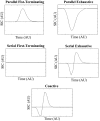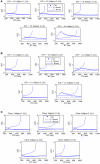An assessment of behavioral dynamic information processing measures in audiovisual speech perception
- PMID: 21980314
- PMCID: PMC3180170
- DOI: 10.3389/fpsyg.2011.00238
An assessment of behavioral dynamic information processing measures in audiovisual speech perception
Abstract
Research has shown that visual speech perception can assist accuracy in identification of spoken words. However, little is known about the dynamics of the processing mechanisms involved in audiovisual integration. In particular, architecture and capacity, measured using response time methodologies, have not been investigated. An issue related to architecture concerns whether the auditory and visual sources of the speech signal are integrated "early" or "late." We propose that "early" integration most naturally corresponds to coactive processing whereas "late" integration corresponds to separate decisions parallel processing. We implemented the double factorial paradigm in two studies. First, we carried out a pilot study using a two-alternative forced-choice discrimination task to assess architecture, decision rule, and provide a preliminary assessment of capacity (integration efficiency). Next, Experiment 1 was designed to specifically assess audiovisual integration efficiency in an ecologically valid way by including lower auditory S/N ratios and a larger response set size. Results from the pilot study support a separate decisions parallel, late integration model. Results from both studies showed that capacity was severely limited for high auditory signal-to-noise ratios. However, Experiment 1 demonstrated that capacity improved as the auditory signal became more degraded. This evidence strongly suggests that integration efficiency is vitally affected by the S/N ratio.
Keywords: capacity; coactive; multisensory integration; parallel; speech.
Figures





References
-
- Altieri N. (2010). Toward a Unified Theory of Audiovisual Integration in Speech Perception. Doctoral Dissertation, Indiana University, Bloomington, IN
-
- Altieri N., Wenger M. J. (2011). “Neural and information processing measures of audiovisual integration,” in Conference of the Vision Sciences Society, Poster Presentation, Naples, FL
Grants and funding
LinkOut - more resources
Full Text Sources

